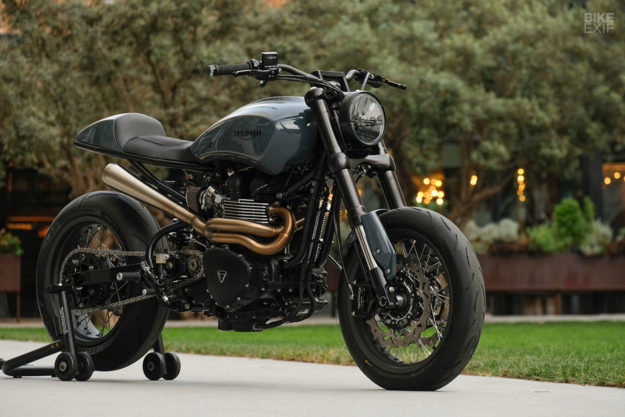
Scramblers are still very much on trend—and the Triumph Scrambler is one of the coolest examples of the breed. But when Justin Webster got his hands on one, he saw potential for something much wilder.
He’s effectively unscrambled this Scrambler 900, transforming it into a tire-shredding, street tracker-styled liter bike—with a touch of cafe racer flair. And it’s such a coherent build, it could easily be mistaken for an OEM concept.
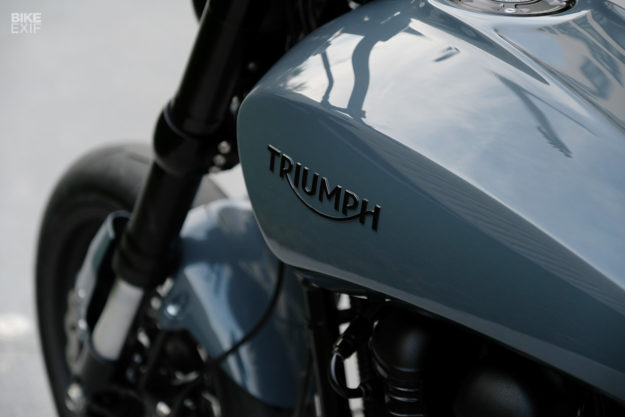
Justin runs J. Webster Designs as a one-man-band out of Gainesville, Florida, where he produces his own line of parts, does fabrication jobs and builds ground-up customs.
But here’s the crazy part: his machining and fabrication skills are self-taught. (He has a degree, but it’s in anthropology.) And this is only his fourth build.
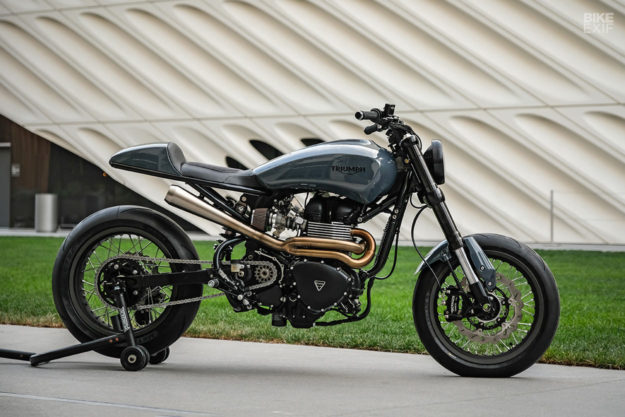
“The Triumph started its life as a 2014 Scrambler with an 865cc motor,” Justin tells us. “I saw something else hidden in the sheep’s clothing that the factory sent it out with, and set about re-imagining the motorcycle into the monster that it was screaming to be.”
Justin started by stripping the frame down to just the backbone. Then he bent up some tubing to build a new rear section, with interesting lines that mimic those of the motor.
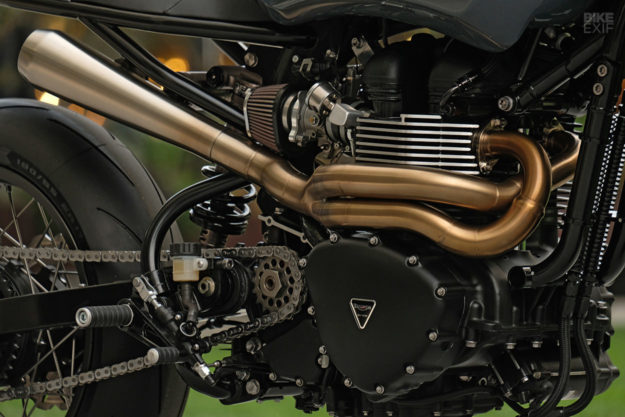
The stock down tubes in front of the engine were removed, then redesigned to turn the motor into a stressed member. End result: a massive weight saving.
Moving to the suspension, Justin converted the Scrambler 900 from a twin shock to a monoshock setup. He’s used a custom-built, fully adjustable shock from Gears Racing USA.
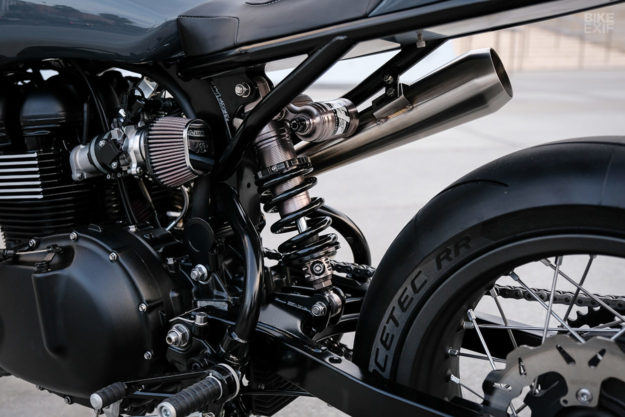
Up front, there’s a set of 50 mm Marzocchi forks from a Ducati Hypermotard. To pair them with the Triumph frame, Justin machined up a new set of triples, with an integrated GPR V4 rotary steering stabilizer. He also designed them with a more aggressive steering geometry than stock.
“The Marzocchi forks have nearly seven inches of travel,” says Justin. “So to match that, I designed the rear mono-shock setup to achieve the same seven inches of travel. This gives the bike an amazingly enjoyable ride on any terrain.”

“It worked so well, that it even made the horrible road conditions of downtown LA feel like a freshly paved race track.”
The wheelset is fully custom: 17” Excel rims, laced to Talon hubs with stainless steel spokes. The rear hub’s a Triumph replacement unit, but the front was originally made for a KTM 990 Adventure. Both rims were finished in a cobalt-colored layer of Cerakote for maximum durability.
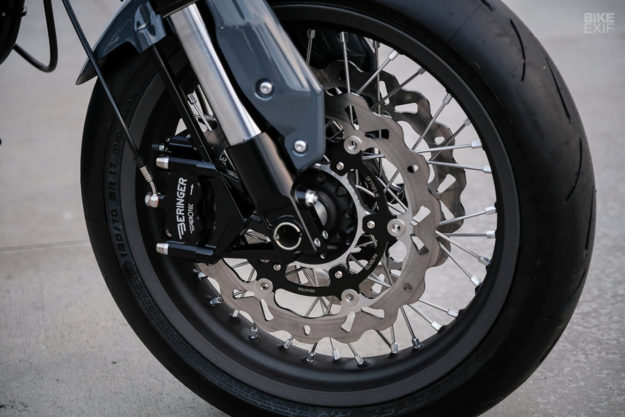
Tires are super-sticky Metzeler Racetec RR K3s, measuring 180/55 R17 in the rear and a 120/70 R17 in the front. Justin upgraded the brakes too, with a full Beringer setup mated to Galfer wave rotors. (Getting the front rotor to fit meant machining custom spacers for the new forks.)
The brake upgrades are more than warranted—because the motor in this Scrambler 900 is far more monstrous than the original. Justin ripped it out, and entrusted it over to Bill Gately of Bonneville Performance for a serious overhaul.
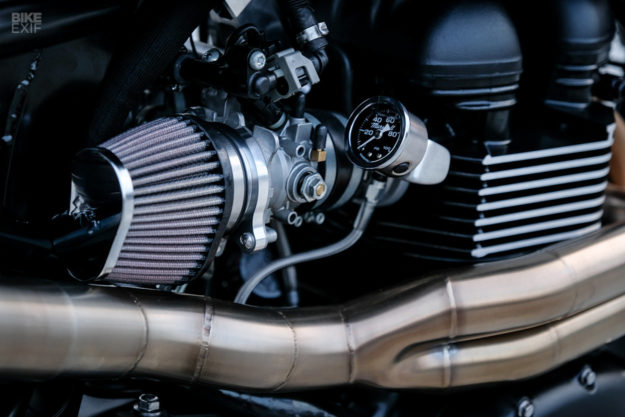
Inside, you’ll find a 995 cc big bore setup, with Bill’s own Nikasil-plated billet aluminum cylinders, Wiseco pistons, and Carillo rods.
The head was worked too, with a full porting and polishing job and a set of custom ground cams. Further down, the counterbalance system was removed, and the crankshaft dynamically balanced, allowing the Triumph to rev more freely.
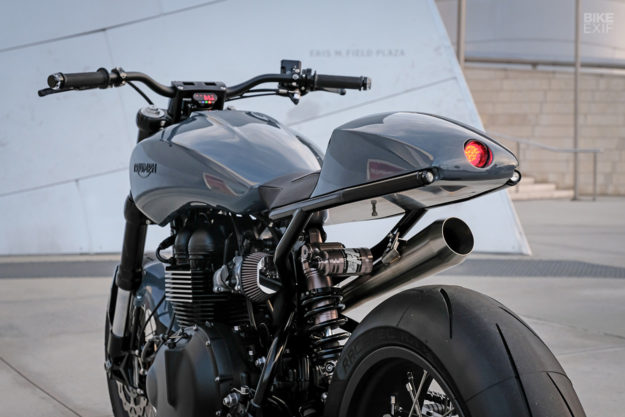
Getting that power where it belongs is a Barnett clutch pack. Justin also made a set of custom 44 mm throttle bodies for the EFI system, to help it flow more air.
“We have doubled the horsepower and torque of the motor with this combination,” says Justin, “and shifted the peak horsepower and torque to a more street friendly RPM range. Gobs of power are on tap at any moment. Just twist the throttle to your desired amount.”

This Scrambler 900 also features all-new bodywork. You’ll probably recognize the fuel tank: it was lifted from an Indian Scout, and altered to fit.
Justin had to graft in the Triumph tank’s tunnel so that he could retain the original fuel pump placement. And he welded in a Suzuki GSX-R fuel filler neck, to give him a wide range of aftermarket filler caps to pick from.
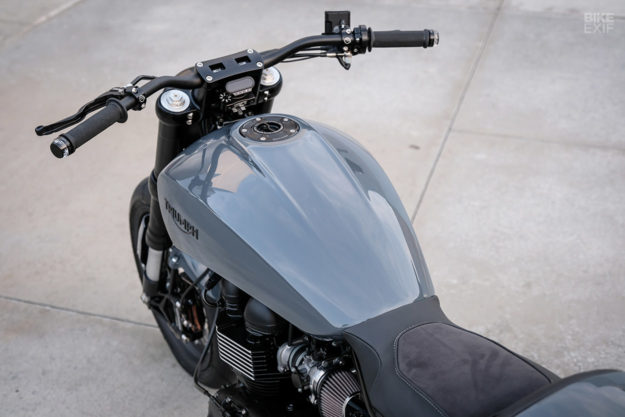
“These modifications have resulted in a significant increase in fuel capacity,” he explains. “With nearly six gallons of fuel available, you’re sure to wear your butt out before running out of fun juice.”
The tail section was sculpted from carbon fiber, to match the lines of the Scout tank. Justin built a two-piece mold, then hand-laid and vacuum formed the final part from multiple layers of carbon fiber. The front fork fender-slash-fork guards followed the same process.
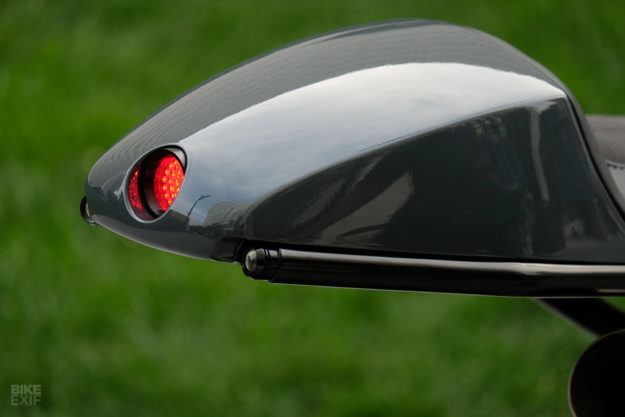
With that out of the way, Justin turned to local vendors to paint and upholster the bike. Justin settled on a custom-mixed grey that’s in the same ballpark as Lamborghini’s ‘Grigio Telesto.’ There’s a tiny bit of green pearl mixed in to help it pop in sunlight. The seat upholstery is mostly Relicate leather, with an Alcantara EXO insert.
All of the above goodness is matched to a new electronics package. The OEM dash is gone, replaced by a tiny speedo and a keyless RFID ignition, both from Motogadget. Lighting is provided by a powerful Truck-Lite LED headlight, and an LED taillight that’s been Frenched into the tail section.
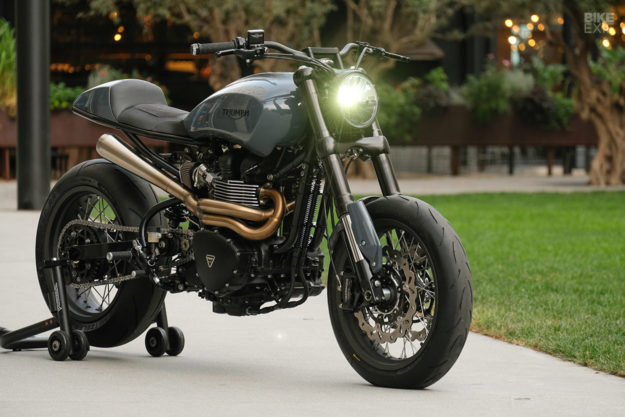
The rear turn signals are embedded in the frame rails, and the front in the bar-ends. Other bits include new handlebars and grips, handlebar clamps, and a Beringer clutch lever. Everything’s powered by a tiny Lithium-ion battery from Ballistic Battery, stashed away in the tail section.
With a huge weight reduction and power boost, and improvements in suspension and braking, Justin really has unleashed the beast. “It’s the tire-shredding, pavement-eating monster that I knew was hiding within,” he says. “This bike is truly an experience when you ride it. It just begs you to twist the throttle and let it eat.”

There’s just one thing Justin’s still trying to figure out: should he make a limited production run of these? Your thoughts, please.
J. Webster Designs | Facebook | Instagram | Images by Sam Bendall
